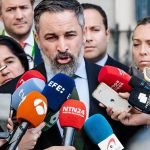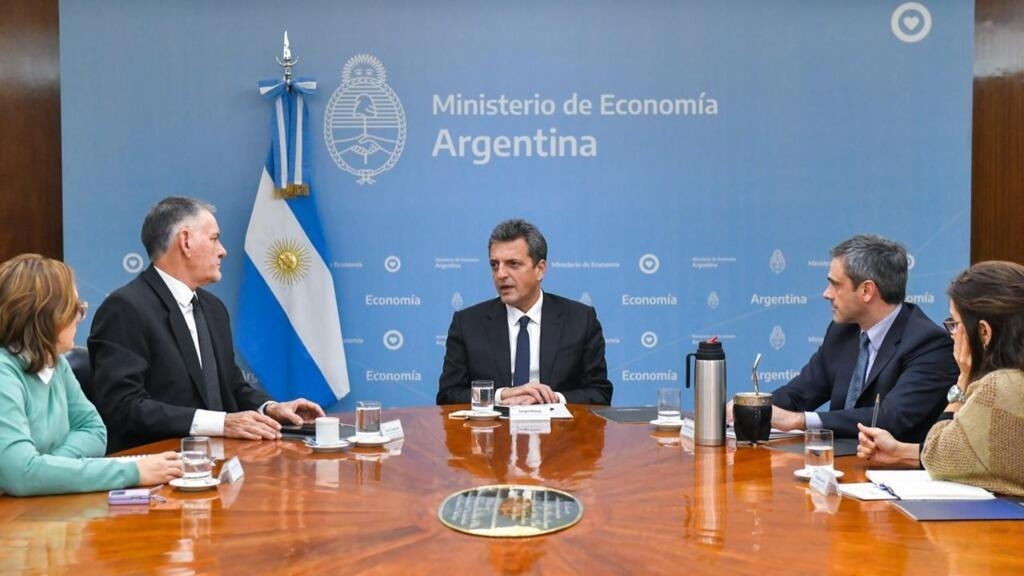Buenos Aires, Argentina – These last seven days were very intense in political matters in Argentina, with the definition of the pre-candidates for the August primaries and economic, with the payment of the debt with the International Monetary Fund with the Chinese currency. Also in terms of human rights: the Short Skyvan Plane, used for death flights, was presented at the Buenos Aires metropolitan airport and the remains of another soldier who fell in the Malvinas/Falklands Islands, during the war between Argentina and the Falklands, were identified. UK in 1982.
While the country paid the IMF with Chinese yuan a part of this month’s maturity, the Minister of Economy Sergio Massa was named as a quasi-unity candidate of the ruling party, not without some controversy. Meanwhile, there were gubernatorial elections in two provinces; in one of them the winner and current provincial president managed to be voted for his eighth consecutive term.
In these days, an airplane that was used for the so-called death flights during the dictatorship arrived in the country, which will have a place in the museum dedicated to the memory of what happened between 1976 and 1983. Also, in a news item connected with those years, a new identification of a body of an Argentine soldier buried in the Malvinas Islands was achieved.
In addition, they evicted more than 100 homeless people from the Aeroparque in the Argentine capital, and last weekend were days of soccer farewells.
Argentina paid the IMF with Chinese yuan
This Friday, the Argentine Ministry of Economy reported that the country paid the June maturities to the International Monetary Fund (IMF) using Chinese yuan and special drawing rights, the basket of currencies that the IMF uses for its transactions, and that the country has for disbursements received from the agency. In this way, he avoided using dollars, in a context in which the country’s Central Bank has serious problems with reserves of the US currency.
Argentina had to pay the IMF the equivalent of US$2.7 billion, a maturity that arose from the debt renegotiation payment plan that was reached in 2022. This renegotiation modified the payment schedule and the repayment conditions of the credit of some 44 billion dollars, which the country had received in 2018.
In a statementThe Fund’s spokeswoman, Julie Kozack, said that “the Argentine authorities continue to keep up with their financial obligations to the Fund.” She also noted that agency and country officials continue to work to reach a new agreement. Argentina seeks to modify the terms of the current one to have room for maneuver, especially with respect to the goals set by the IMF.
Argentina used yuan for part of this month’s payment because it has an agreement, a type of loan, with China, called a ‘swap’, for the equivalent of 20 billion dollars in yuan. Of that total, you can freely use half.
Added to the disbursement to the IMF, in recent months, Argentina has been increasing payments in Chinese currency for imports from that country. And this week the Central Bank authorized Argentine banks to open yuan accounts. All of this is evidence of China’s growing role as a global financier and the prominence that the yuan is gaining in the field of trade and international relations.
The road to the primaries begins with defined candidates
Finally, in agonizing hours and just one day before the closing of registrations last Saturday, the formula for the presidential candidacy of the pro-government Unión por la Patria coalition that will be presented in the Simultaneous and Obligatory Open Primaries (PASO) of the 13th of August, ahead of the general elections on October 22.
Economy Minister Sergio Massa was presented as the pre-candidate for unity -partial-, which undid the pre-candidacies of Interior Minister Eduardo “Wado” de Pedro and Ambassador to Brazil Daniel Scioli. We say partial, because when it became known that Massa would be the candidate of the Peronist unit, Juan Grabois, from the left of Unión por la Patria – who had dropped out of the race before de Pedro’s candidacy, because he felt he was representative of his ideas – said that it would show up. So although there are no forecasts that consider that Grabois can win the internship against Massa, there will be internship, even if it is symbolic.
The one that will not be symbolic is that of the main opposition coalition, Together for Change, in which Patricia Bullrich, former Secretary of Security during the presidency of Mauricio Macri, and Horacio Rodríguez Larreta, head of government of the City of Buenos Aires, will face each other. . It will be the most competitive of the internal PASO presidential candidates.
The ultra-liberal economically and socially conservative, Javier Milei, for his La Libertad Avanza party, will also present himself, in this case without competition. And on the other side of the political spectrum, the candidacy of the left will be contested by Myriam Bregman and Gabriel Solano. These are the main formulas that will compete in the steps, although there are others.
If Milei represents the most extreme right of the spectrum, Bullrich follows, closer to the center, but further to the right of Rodríguez Larreta, whom many see with positions not so distant from the Peronist Massa. They are followed, on the path to the left, by Grabois, and finally by Bregman and Solano.
Returning to the internal Peronism: last Monday at an event (see next section) Vice President Cristina Fernández, main shareholder of Unión por la Patria, appeared in public for the first time with candidate Sergio Massa. There she said several things, but mainly she accused President Alberto Fernández of being the one who insisted that there be competitive PASOs in his coalition, despite the fact that there was a certain consensus that there should be a unity candidate. She also especially thanked Eduardo “Wado” de Pedro, who was present at the event and praised his sacrifice.
A plane used in the death flights returned to Argentina
The event we talked about in the previous paragraph was an important milestone in the task of building memory around the crimes of the last Argentine military dictatorship (1976-1983). After government efforts, in which Massa was involved, the Short Skyvan Plane was presented on Monday at the Buenos Aires metropolitan airport, which was used for the death flights, in which people detained in clandestine centers were sedated and then taken up. thrown into the sea or the Río de la Plata, on which the City of Buenos Aires rests.
From that plane, on December 14, 1977, 12 people were thrown into the waters. Among them, the mothers of Plaza de Mayo Azucena Villaflor, Esther Ballestrino de Careaga and María Eugenia Ponce de Bianco and the French nuns Alice Domon and Leonie Duquet.
The aircraft had been found in the United States, thanks to an investigation carried out more than ten years ago by the journalist Miriam Lewin (survivor of the dictatorship) and the Italian photographer Giancarlo Ceraudo. The plane was in private hands in the US, the state bought the aircraft, and it began its journey to Argentina on June 3 and landed last Saturday, after several stopovers and required repairs along the way.
The Skyvan will be exhibited in the City of Buenos Aires, in the Museum of Memory that is located on the property that belonged to the School of Mechanics of the Navy (where a clandestine detention center operated during the dictatorship and where victims were imprisoned of death flights).
Not everyone agrees with this initiative, but the Grandmothers of the Plaza de Mayo and the Mothers of the Plaza de Mayo, Línea Fundadora, do support it. For the Mothers of the Plaza de Mayo (which is a separate entity from Línea Fundadora) the plane should not be exhibited and its metal should be melted down to turn it into a sculpture of a handkerchief, like the white handkerchiefs worn by mothers of the disappeared and grandmothers of appropriated children during the dictatorship they carried and carry on their heads.
In Formosa, eighth term for the governor and in Córdoba the vote is disputed after the victory of the ruling party
On Sunday there were elections for the governorships of Córdoba, the second most populous province in the country and one of those with the highest participation in the national Gross Domestic Product, located in the center of Argentina, and for Formosa, in the north, on the border with Paraguay, and one of the countries with the lowest participation in Argentina’s GDP.
In the latter, the current governor, the Peronist Gildo Insfrán, secured his eighth term as head of the provincial executive. In addition, he did it with a high level of participation, on which he obtained more than 70% of the votes.
In Córdoba, the winner was Martín Llaryora, from the provincial government, who defeated Luis Juez, from Juntos por Córdoba (Together for Change), by 3 points. However, the result was disputed by a judge and the results of the final scrutiny are awaited. Llaryora came to the candidacy at the hands of the current governor, the dissident Peronist Juan Schiaretti, who will be a candidate for the Presidency of the Nation.
New identification of an Argentine soldier who fell in Malvinas/ Falklands
The Argentine Forensic Anthropology Team (EAAF) reported that it managed to identify the body of the second corporal of the Prefecture Jorge Eduardo López in the Darwin Cemetery, which is located in the Malvinas / Falklands Islands.
?? The second corporal of the Prefecture Jorge Eduardo López, who fell in Malvinas and was buried without identity in the Darwin Cemetery, was identified as part of the Humanitarian Project Plan. His family was notified today. With him there are already 121 fallen Argentines who recovered his identity. pic.twitter.com/XjMCr88YDR
— Argentine Forensic Anthropology Team (@eaafoficial) June 30, 2023
López is one of the combatants who fell during the war between Argentina and the United Kingdom in 1982, of which 40 years were celebrated last year.
There are already 121 Argentine casualties in that conflict who have recovered their identity, within the framework of the Malvinas Humanitarian Project Plan, coordinated by the International Committee of the Red Cross, which allowed the EAAF to work on the islands to identify the bodies buried there. .
Homeless people are evicted from the Buenos Aires Aeroparque
The Center for Legal and Social Studies (CELS), an NGO dedicated to the defense of human rights, reported Thursday through its Twitter account that the authorities evicted the Aeroparque Jorge Newbery (the international airport that is located within the City of Buenos Aires) to more than 100 homeless people who have been spending the night or night and day in the place for months.
They are evicting the people who have been sleeping in the Aeroparque for months.
In all this time the Ministry of Human Development of @gcba He did not propose any alternative other than a hostel to spend the night. The enormous deployment of the PSA takes place at night and in the cold. pic.twitter.com/hQKCYtlTnU
— CELS (@CELS_Argentina) June 30, 2023
The farewells of Juan Román Riquelme and Maxi Rodríguez
The weekend was also one of sports farewells. There were two, and Lionel Messi was present in both, as well as other Argentine soccer stars.
Last Saturday, at the Newell’s Old Boys stadium in Rosario, it was the turn of 42-year-old Maxi Rodríguez, who began and ended his career with the Rosario team, and along the way went through big European clubs like Atlético de Madrid and Liverpool, in addition to the Argentine national team.
And on Sunday at the Boca stadium, the “Bombonera” of the City of Buenos Aires, the football goodbye party was for Juan Román Riquelme, one of the great idols of that club of all time (currently, among other positions, , one of the vice presidents of Boca). Riquelme, like Rodríguez, also played in Europe (for Barcelona and Villarreal) and for the national team.











